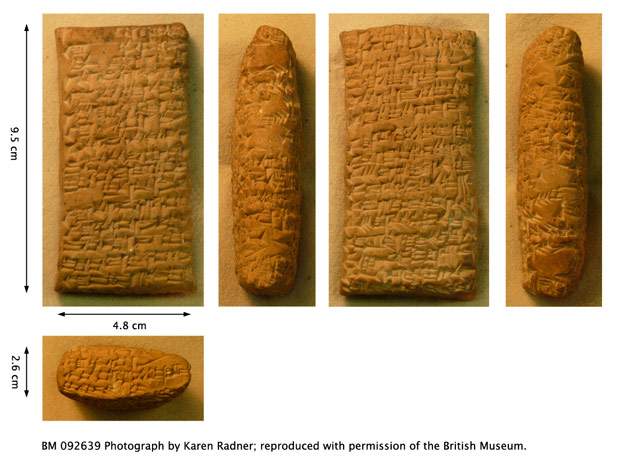BM 092639: marriage contract, from Sippar

BM 092639: marriage contract, from Sippar, reign of Apil-Sin (Old Babylonian period, c.1820 BC). Photograph by Karen Radner; reproduced with permission of the British Museum. View large image.
This private legal document records a marriage agreement made in the city of Sippar PGP in northern Babylonia. According to the required format of a text of this nature, the original document consisted of an inner tablet and a clay envelope (see BM 082512 and BM 082513). The envelope would have been inscribed with a copy of the text on the inner tablet and impressed with the seals of the witnesses. In our case, only the inner tablet has survived. In all likelihood the envelope was removed in antiquity in order to make it invalid, because it was superseded some years later by another marriage agreement between the same people.
The tablet shown here documents an agreement between the husband Warad-Šamaš and his two wives. It stipulates the hierarchy between the two wives, with one subordinate to the other. Her duties to the first wife are specified as follows: washing her feet, carrying her chair to the temple (as the first wife was a temple devotee), sharing her opinions ("Whenever the first wife is angry, the second wife will be angry; whenever the first wife is friendly, the second wife will be friendly"), respecting her privacy ("She shall not break her seals"), and grinding one litre of flour per day for her. We know from an earlier text that Warad-Šamaš and the first wife had been married for some time but this marriage was childless, not necessarily because the first wife was barren but because her status as a temple devotee required her to remain chaste. This was the reason for adding the second wife to the family.
Our document also deals with two possible divorce scenarios. If the two wives, who are treated as a unit, initiated the divorce they would be punished with death. In other words, the document's objective is to preclude the wives' right to divorce. If the husband demanded a divorce he would forfeit "house and furniture". That is, a divorce was possible for him but only at great financial cost. Some time later, after the second wife had given birth to a son, a new agreement was drafted which imposed even heavier financial penalties onto the husband, should he seek a divorce. This new document again stresses the unity of the two wives by presenting the son as their child together. All arrangements made in the legal documents of Warad-Šamaš and his family are in line with the relevant laws in the Codex Hammurabi.
To see a scale drawing of the text, view the record for this tablet on the British Museum's research database [http://www.britishmuseum.org/research/search_the_collection_database.aspx].
A transliteration and translation of the text can be found in Westbrook, Old Babylonian Marriage (1988), pp. 116-117 (= CT 2, 44). The three marriage agreements are discussed in detail by Harris, 'Three Babylonian Marriage Contracts' (1974).
Content last modified on 10 Jan 2017.
Karen Radner
Karen Radner, 'BM 092639: marriage contract, from Sippar', Knowledge and Power, Higher Education Academy, 2017 [http://oracc.museum.upenn.edu/saao/knpp/cuneiformrevealed/tabletgallery/bm092639/]